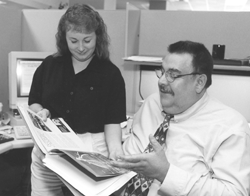The Winning Equation: Access + Attitude = Success

People with disabilities are underrepresented in many challenging careers, including those in science, mathematics, technology, and engineering. Negative stereotyping and attitudes are reported as the most significant factors faced by people with disabilities in these fields. At the pre-college level students with disabilities are often discouraged from taking math and science courses and, when enrolled, are often not fully included in rigorous work in these classes. Poor high school preparation limits their options in college and careers.
To improve opportunities for students with disabilities in science, mathematics, technology, and engineering, DO-IT has launched a variety of programs. The DO-IT MATH-SCI project works with high school math and science teachers to help them fully include students with disabilities in their classes. It is funded by an Eisenhower grant. MATH-SCI stands for Making Accommodations that Help Schools Create Inclusion.
Conversations about disabilities in an educational setting are often dominated by the one-size-fits-all syndrome. Whether we are talking about a person who has a physical, sensory, learning, or cognitive disability, we like to have simple solutions that fit all. In truth, students with disabilities have the same variety of needs and preferences as anyone else. Although the energy and construction costs of every business could be cut dramatically by simply lowering all of the interior ceilings to a maximum height of 52 inches and this solution would work very well for many people who use wheelchairs or are of short stature, others might grumble when they have to maneuver on their knees as they move around the office. This kind of narrowly focused, inadequate, uniform solution is often imposed on the student with a disability, creating an educational environment that is counterproductive.
The MATH-SCI project has developed a model process and a Student Activities Profile form for creating effective accommodations in science and math classes. It can be used by any teacher and is composed of the following four steps:
Step #1: What does the task or assignment require?
Break down all of the components of the experiment, assignment, or exercise. As an educator, you are usually focused on the overall outcome of the project. To accommodate a student with a disability it's important to think about the specific settings, tools, skills, and tasks that are required at each step. By analyzing and evaluating the task thoroughly you will be able to determine how best to fully and effectively include a student with a specific disability.
Step #2: What physical, sensory, and cognitive skills are needed?
Match the tasks required to the physical, sensory, and cognitive skills needed to successfully complete the project. It is easy to say, "If I had a physical, sensory, or cognitive disability I would not be able to complete this assignment," without really determining what skills are needed for specific aspects of the project. We need to separate the "real" requirements of a specific task from the "fictional or perceived" requirements of the project in total. It is impossible to place yourself in the shoes of the student with a disability. They may have learned many ways to solve a specific problem or task and work around the limitations imposed by the disability.
Step #3: What components of the task require accommodation?
Once the task has been analyzed and the skills needed are identified, determine what accommodations may be required or how the learning experience might be altered to make it more accessible. Determine the level of difficulty of the project and determine how best to make an accommodation to create an inclusive environment for a student with a disability. It is very important to consult with the student to determine what they perceive as aspects of a project which they may need an accommodation or assistance.
Step #4: What accommodation options exist?
Now that the tasks that need accommodation have been determined, identify what resources exist for providing the needed accommodation(s). The student may have some good ideas, however, this is a time when other staff and professionals may have expertise in specific areas and be called on to provide input. In some cases, having students work in groups where each person is assigned a task that they have the ability to complete provides a reasonable alternative.
DO-IT MATH-SCI has created a brochure and videotape ($25) with the title, The Winning Equation: Access + Attitude = Success in Math and Science. In addition, made available through DO-IT are comprehensive program development materials titled Accommodating Students with Disabilities in Math and Science: A RESOURCE FOR TEACHERS ($70). Send a request and check to DO-IT to order these materials.